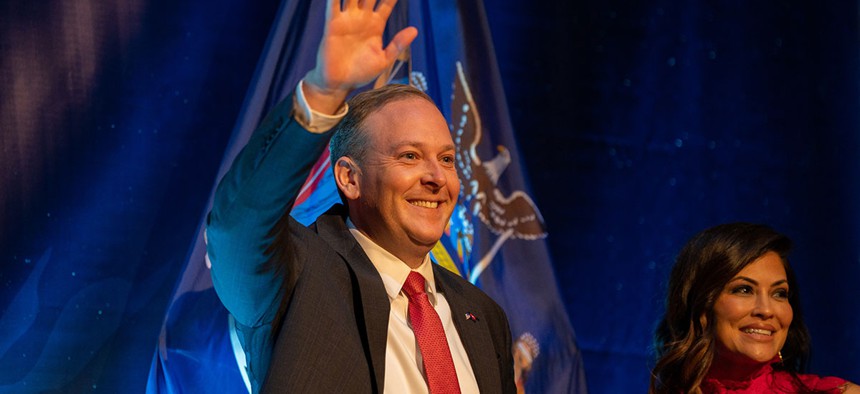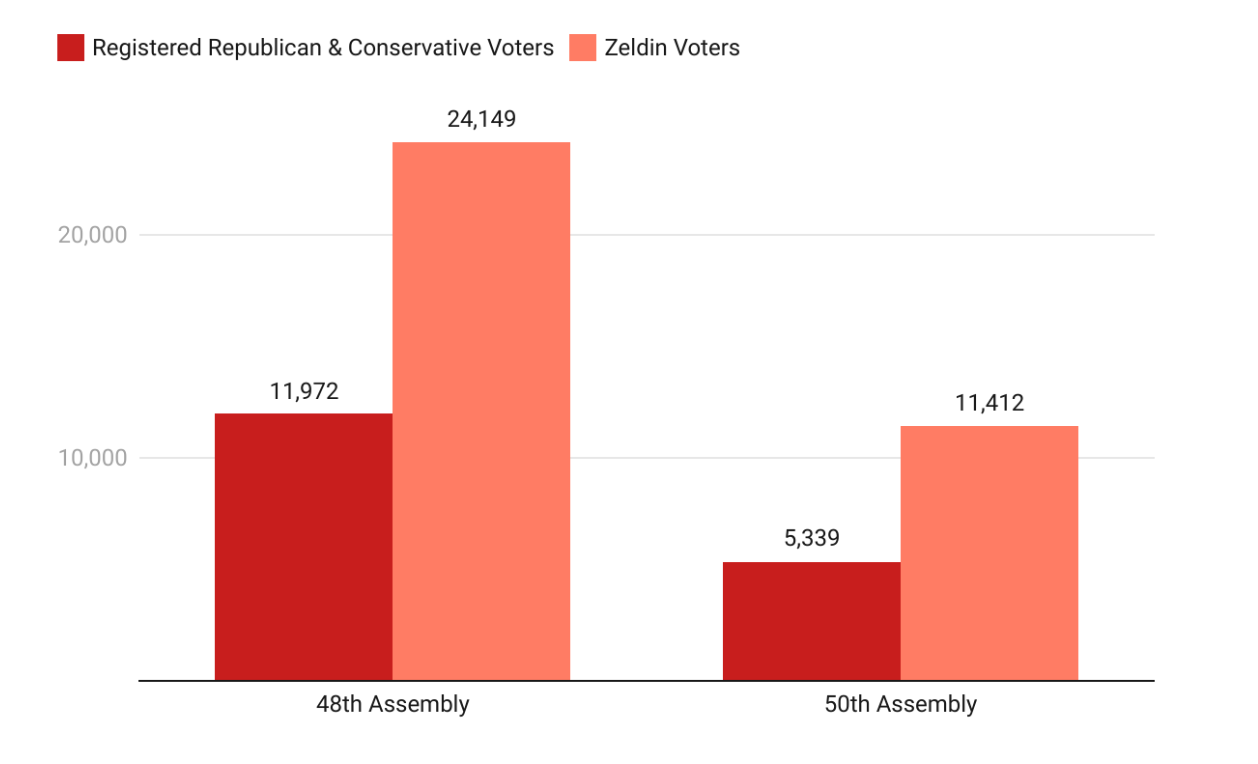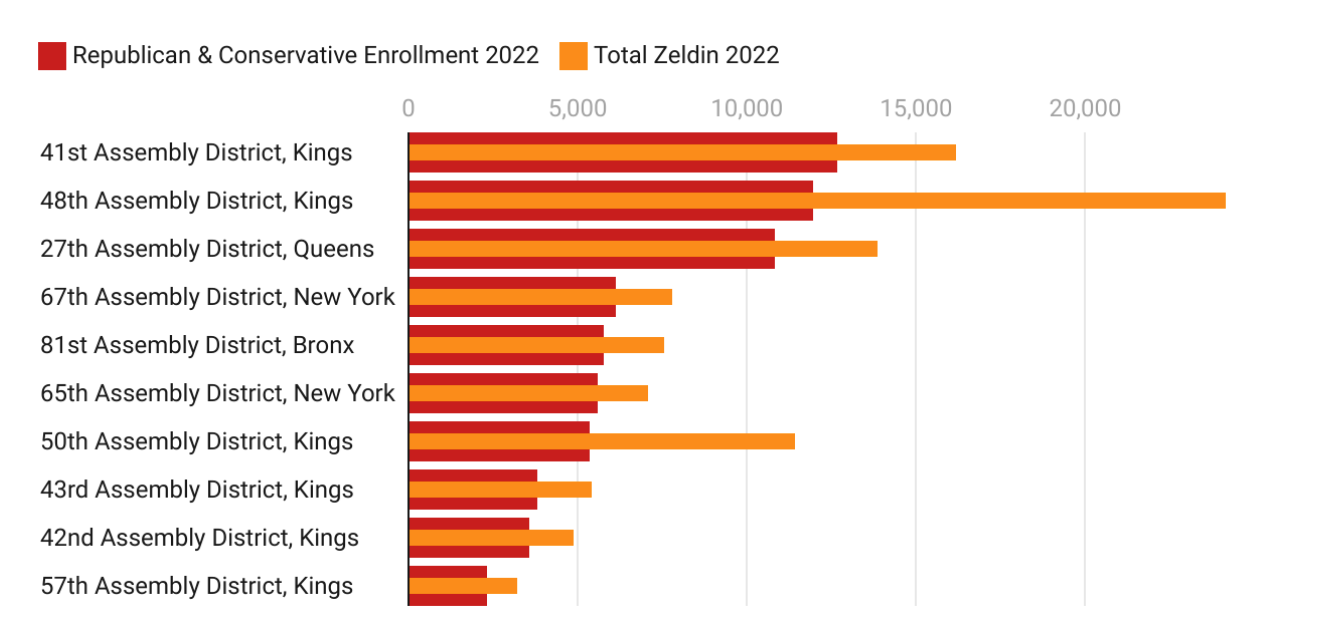Politics
Votes for Lee Zeldin outnumbered registered Republicans in most New York City Assembly districts
Diving into the numbers shows Republicans doubled their support in the governor’s race New York City by flipping Democrats and independents.

Republican gubernatorial candidate Lee Zeldin waves to supporters at his election night party on November 8, 2022 in New York City. David Dee Delgado/Getty Images
Assembly Member Emily Gallagher represents a district with a significant Hasidic Jewish population, in Williamsburg, Brooklyn. Gallagher is a Democrat, but she also runs on the Working Families Party line in Assembly District 50, and earned progressive endorsements, from the likes of the Democratic Socialists of America and Rep. Alexandria Ocasio-Cortez on her way to an unopposed victory in the Nov. 8 general.
But on that same day, nearly twice as many people voted for Republican candidate for governor Lee Zeldin as there were registered Republicans or Conservatives in Gallagher’s district.
That was also the case in Assembly Member Simcha Eichenstein’s district, covering primarily Orthodox Jewish neighborhoods in southern Brooklyn. Eichenstein runs on both the Democratic and Conservative lines. And while many of Eichenstein’s supporters are registered Democrats, they still voted for the Republican.

Those districts are the most dramatic example of what Election Day looked like across the city. Turnout overall shrunk from 46% in 2018 to 38% this year, but voters backing Zeldin came out in force. Zeldin not only reached his goal of getting 30% of the New York City vote, but he did so well that there is no mathematical way to get so many votes without flipping tens of thousands of Democratic and independent voters.
Getting to 30% meant improving on Marc Molinaro’s performance as the Republican candidate in 2018. When he ran against former Gov. Andrew Cuomo, he got 15.2% of the New York City vote. Zeldin got to 30.1%, doubling his share of the vote versus Hochul.
Comparing registration numbers in November to the vote counts cannot tell us how many Democrats or independents voted for Zeldin. In fact, Barry Burden, political science professor at the University of Wisconsin-Madison, notes that voter registration is not usually a great indicator of how people end up voting.
“In New York state there are about as many people who are registered with no party as there are registered Republicans,” Burden said. “So it would not be surprising for a Republican candidate to win more votes that would be expected from registration numbers alone.”
But it’s notable, since these numbers usually aren’t this lopsided. In 2022, 43 out of 61 assembly districts based in the city reported more votes for Zeldin than there were registered Republican voters. That wasn’t true for a single Assembly district in 2018, despite the higher overall turnout that year. It also wasn’t the case in a single district in 2014, when Cuomo was reelected facing Republican Rob Astorino.

Queens’ most dramatic example comes from Assembly District 27, where Democratic Assembly Member Daniel Rosenthal ran against Republican Angelo King in a district with significant Asian and Orthodox Jewish populations. Rosenthal won his seat, but Hochul lost the district, underperforming Rosenthal by about 3,000 votes. Zeldin got about 3,000 more voters than there are registered Republicans and Conservatives in the district.
The same thing happened in Assembly District 65, which includes Manhattan’s Chinatown and where Assembly Member-Elect Grace Lee will replace Assembly Member Yuh-Line Niou in January. There, 1,500 more people voted for Zeldin than there were registered Republican or Conservative voters – despite overall turnout in the district of just 37%.
These numbers, recently certified by the New York City Board of Elections, show a Democratic Party losing its grip over Asian and Orthodox Jewish voters in particular, but results are stark across the city.
“In recent presidential elections in the state, Democrats have won by more than 20 percentage points, but Hochul won by only 6.4 points,” Burden said. “In that environment Zeldin and other Republicans certainly benefited from some crossover support from Democratic and independent voters.”
The New York State Board of Elections doesn’t have voter registration numbers from 2002 broken down by Assembly district, but George Pataki, the last Republican governor for New York, won about 533,000 votes within New York City on the Republican and Conservative lines, which was equal to 95% of the number of voters enrolled in those parties in the city at the time.
When Molinaro ran, he got votes equal to 65% registered voters in the Republican and Conservative parties. Zeldin’s votes equaled 111% of the voters registered in those parties. Hochul, by contrast, got votes equaling just 39% of the total active registered Democrats and Working Families Party members.
Even in Assembly districts where Zeldin got fewer votes than there were enrolled Republicans, the results show significant shifts. Assembly District 68, covering East Harlem, had some of the lowest Republican turnout in Manhattan in 2018. Cuomo secured 90% of the vote when he ran, with Hochul as the lieutenant governor.
Not only did Hochul’s vote share vis-a-vis Cuomo shrink by 7 points, but Zeldin’s vote count equaled 98% of Republican enrollment in the district. In fact, the district represented by Assembly Member Edward Gibbs looked more like Eichenstein’s did in 2018, when Molinaro’s vote count equaled 90% of Republican enrollment.
Zeldin’s performance in District 68 overperformed that of the Republican running for Assembly, Daby Benjaminé Carreras, who netted about 3,000 votes versus Zeldin’s 4,000 – while Hochul slightly underperformed Gibbs. Voters interviewed on Election Day who were supporting Zeldin often asked not to be identified by their last name – possibly reflecting public discomfort with voting for a Republican in a heavily Democratic neighborhood – but they did speak to a frustration towards COVID-19 restrictions, poignant as some masking advisories have returned to New York during the current so-called “tripledemic” outbreak of COVID-19, Influenza and respiratory syncytial viruses.
“I believe in the changes he would like to bring to New York,” said Elizabeth R., a 45-year-old who wasn’t registered with any party. “I don’t support how they handled the pandemic.”
The story repeats itself in one of the districts in the Bronx where Zeldin got more voters than registered Republicans and Conservatives. Assembly Member Michael Benedetto represents Assembly District 82, including Co-Op City, City Island, and Throggs Neck. The district used to be represented by Democrat Stephen Kaufman – an Assembly Member-turned personal injury lawyer who himself endorsed Zeldin in September.
District 82 has a 40% Hispanic population and 26% Black population. That district also gave Zeldin the most votes out of any Bronx district – about 11,000, reflecting, in part, Zeldin’s gaining Republican votes among Latino voters as well.
While Democratic campaign leadership remains in place in the aftermath of Hochul’s narrow victory in November, some Democrats continue to warn that Zeldin’s performance is a canary in a coal mine. Lee tweeted that the departure of Asian-American voters from the party is “a five-alarm fire that we should respond to with both urgency and intention.”
NEXT STORY: What’s Eric Adams’ plan for Albany in 2023?

